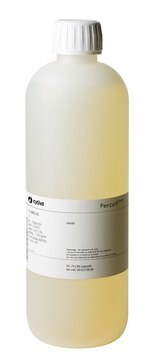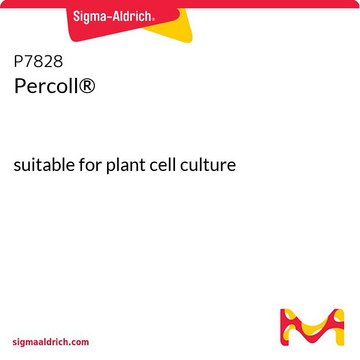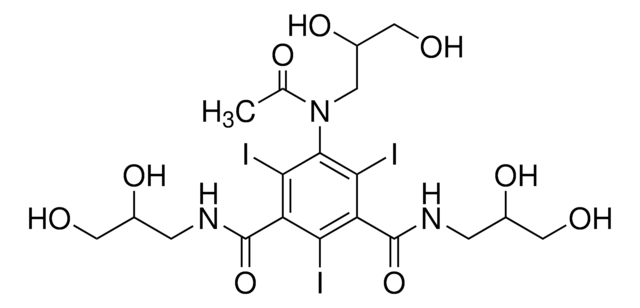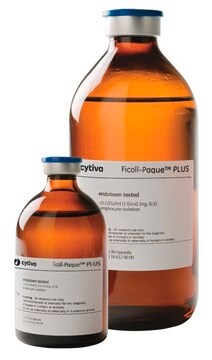P4937
Percoll®
pH 8.5-9.5 (25 °C), suitable for cell culture
Synonym(s):
Density gradient medium
Sign Into View Organizational & Contract Pricing
All Photos(1)
About This Item
Recommended Products
sterility
aseptically filled
Quality Level
technique(s)
cell culture | mammalian: suitable
single cell analysis: suitable
pH
8.5-9.5 (25 °C)
density
1.13 g/mL±0.005 g/mL at 25 °C (lit.)
storage temp.
2-8°C
Looking for similar products? Visit Product Comparison Guide
General description
Percoll® is a classic medium for density gradient centrifugation of cells, viruses, and subcellular particles. It consists of colloidal silica particles of 15-30 nm diameter (23% w/w in water), which have been coated with polyvinylpyrrolidone (PVP). The PVP coating renders the product completely non-toxic and ideal for use with biological materials. Due to its heterogeneity in particle size, sedimentation occurs at different rates, spontaneously creating very smooth, isometric gradients in the range of 1.0-1.3 g/ml.
Application
Percoll consists of colloidal silica particles of 15-30 nm diameter (23% w/w in water) which have been coated with polyvinylpyrrolidone (PVP). It is used to establish non-toxic low viscosity, low osmolarity density gradients that can be used to isolate cells, organelles and viruses. It has been used to separate inner and outer membrane vesicles from E. coli. Percoll is isosmotic throughout the gradient, non-toxic, and is easily removed from the purified materials.
Percoll® has been used in the centrifugal separation of:
- neonatal rat ventricular cardiomyocytes
- leucocytes from a blood sample
- peritubular myoid (PM) cells
Features and Benefits
- Low osmolality permits precise adjustment to physiological conditions without significant interference from the medium.
- Compatible with living cells and viruses and allows separation and recovery of intact, fully active systems.
- Impermeable to biological membranes, resulting in no change of buoyant density of particles during centrifugation.
- Spontaneous formation of gradient during centrifugation allows mixing of large sample volumes in the centrifuge tubes.
- Low viscosity results in rapid formation of gradients and particle separation.
- Most biological particles having sedimentation coefficient values greater than 60S can be successfully isolated in Percoll gradients.
Legal Information
Percoll is a registered trademark of Cytiva
related product
Product No.
Description
Pricing
Storage Class Code
12 - Non Combustible Liquids
WGK
nwg
Flash Point(F)
Not applicable
Flash Point(C)
Not applicable
Personal Protective Equipment
dust mask type N95 (US), Eyeshields, Gloves
Certificates of Analysis (COA)
Search for Certificates of Analysis (COA) by entering the products Lot/Batch Number. Lot and Batch Numbers can be found on a product’s label following the words ‘Lot’ or ‘Batch’.
Already Own This Product?
Find documentation for the products that you have recently purchased in the Document Library.
Customers Also Viewed
Cristina Pérez-Patiño et al.
Scientific reports, 9(1), 705-705 (2019-01-27)
The preservation of sperm functional parameters and fertility post-cryopreservation largely varies in the porcine, a species with a fractionated ejaculate. Although intrinsic individual differences have primarily been linked to this variation, differences in protein abundance among frozen-thawed (FT)-spermatozoa are far
Density gradients prepared from colloidal silica particles coated by polyvinylpyrrolidone (Percoll).
H Pertoft et al.
Analytical biochemistry, 88(1), 271-282 (1978-07-15)
Nunzia Pastore et al.
Nature communications, 11(1), 2461-2461 (2020-05-20)
It is well established that pluripotent stem cells in fetal and postnatal liver (LPCs) can differentiate into both hepatocytes and cholangiocytes. However, the signaling pathways implicated in the differentiation of LPCs are still incompletely understood. Transcription Factor EB (TFEB), a
Yi-Ling Liu et al.
Molecular neurodegeneration, 12(1), 30-30 (2017-04-26)
Microglia mediate amyloid-beta peptide (Aβ)-induced neuroinflammation, which is one of the key events in the pathogenesis of Alzheimer's disease (AD). Decoy receptor 3 (DcR3)/TNFRSF6B is a pleiotropic immunomodulator that promotes macrophage differentiation toward the M2 anti-inflammatory phenotype. Based on its
Yanping P Chen et al.
The Journal of eukaryotic microbiology, 56(2), 142-147 (2009-05-22)
Nosema ceranae, a microsporidian parasite originally described from Apis cerana, has been found to infect Apis melllifera and is highly pathogenic to its new host. In the present study, data on the ultrastructure of N. ceranae, presence of N. ceranae-specific
Our team of scientists has experience in all areas of research including Life Science, Material Science, Chemical Synthesis, Chromatography, Analytical and many others.
Contact Technical Service











